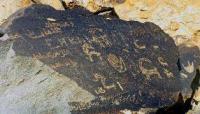You are here
Petroglyphs of Vagashton.

Photos tour on petroglyphs Tajikistan.
“The universe contains many planets which make it what it is – a unified system. In addition, our bodies contain many organs, and each part is congruent to a planet in our solar system. The universe we see out our eyes is a mirror of what is within us. This is what God meant by making man in his image. We are all made as a reflection of God and that reflection of him is within us. Furthermore, not only are all religions connected to the same Truth, or Cosmic Heart, but this concept is also mirrored in the pantheons of ancient religions, where each of the many gods simply represented one set of characteristics of the ONE. And in all cases, these many gods symbolized the planets, therefore mimicking the different parts of the universe and the ONE God’s many mirrors (He Who is All). The structure behind all polytheistic religions of the past and present is one and the same. They are all built on the same foundation as Nature”
Suzy Kassem.
Photos petroglyphs of Tajikistan.
The petroglyphs are north-east of the village of Vagishton in the Pyandzhikent district, in village council Shing, on the left bank of the Vagishton Sai. Description of the Site The petroglyphs are carved on the vertical surface of a limestone rock, 1.4 х 1.65 х 1.45m.
The surface of the rock and the drawings are covered with a thick layer of desert patina. Wind erosion and the intense desert patina make the petroglyphs almost invisible. More than 50 images were identified. Most of them are humans carved in a linear manner.
According to the poorly preserved images, one can assume there had been many more. Humans are accompanied by goats, a horizontal line more than 1m long, and cross lines. Humans are shown with hands spread apart, with male genitals clearly apparent, and two dots on their chests. In the center of the panel, there is a coital scene with a solar sign above it.
There are several more or less clear scenes: two humans and an animal, possibly an Asiatic wild ass; next to them three humans are holding hands and performing a type of dance. On the right side of the rock, a complex composition is interpreted as a hunting track, an enclosure for wild prey and a group of hunters.
A scene below it shows a man carrying a small animal resembling a goat cub in his stretched out hands; there is one more human figure, apparently, with a dog and another human. Technique All drawings are pecked.
The site was discovered and researched by Dalskiy A.N. in 1947 (Dalskiy 1949: 190-192, 1950: 234 - 236). Dating From the complexity of composition, and the manner of depicting people and to some extent animals, the petroglyphs are distinct from other rock images in Zeravshan.
Dalskiy dated the Vagishton Sai petroglyphs to the Neolithic (VIth – IVth millennia BC), but apparently they would date to a later period, the Bronze Age.
Authority:
Bobomullo S. Bobomulloev.
Photos by
Surat Toymasov.







